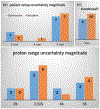NRG Oncology and Particle Therapy Co-Operative Group Patterns of Practice Survey and Consensus Recommendations on Pencil-Beam Scanning Proton Stereotactic Body Radiation Therapy and Hypofractionated Radiation Therapy for Thoracic Malignancies
- PMID: 38395086
- PMCID: PMC11209785
- DOI: 10.1016/j.ijrobp.2024.01.216
NRG Oncology and Particle Therapy Co-Operative Group Patterns of Practice Survey and Consensus Recommendations on Pencil-Beam Scanning Proton Stereotactic Body Radiation Therapy and Hypofractionated Radiation Therapy for Thoracic Malignancies
Abstract
Stereotactic body radiation therapy (SBRT) and hypofractionation using pencil-beam scanning (PBS) proton therapy (PBSPT) is an attractive option for thoracic malignancies. Combining the advantages of target coverage conformity and critical organ sparing from both PBSPT and SBRT, this new delivery technique has great potential to improve the therapeutic ratio, particularly for tumors near critical organs. Safe and effective implementation of PBSPT SBRT/hypofractionation to treat thoracic malignancies is more challenging than the conventionally fractionated PBSPT because of concerns of amplified uncertainties at the larger dose per fraction. The NRG Oncology and Particle Therapy Cooperative Group Thoracic Subcommittee surveyed proton centers in the United States to identify practice patterns of thoracic PBSPT SBRT/hypofractionation. From these patterns, we present recommendations for future technical development of proton SBRT/hypofractionation for thoracic treatment. Among other points, the recommendations highlight the need for volumetric image guidance and multiple computed tomography-based robust optimization and robustness tools to minimize further the effect of uncertainties associated with respiratory motion. Advances in direct motion analysis techniques are urgently needed to supplement current motion management techniques.
Copyright © 2024 Elsevier Inc. All rights reserved.
Figures




Update of
-
Proton Pencil-Beam Scanning Stereotactic Body Radiation Therapy and Hypofractionated Radiation Therapy for Thoracic Malignancies: Patterns of Practice Survey and Recommendations for Future Development from NRG Oncology and PTCOG.ArXiv [Preprint]. 2024 Feb 1:arXiv:2402.00489v1. ArXiv. 2024. Update in: Int J Radiat Oncol Biol Phys. 2024 Jul 15;119(4):1208-1221. doi: 10.1016/j.ijrobp.2024.01.216. PMID: 38351927 Free PMC article. Updated. Preprint.
Similar articles
-
Proton Pencil-Beam Scanning Stereotactic Body Radiation Therapy and Hypofractionated Radiation Therapy for Thoracic Malignancies: Patterns of Practice Survey and Recommendations for Future Development from NRG Oncology and PTCOG.ArXiv [Preprint]. 2024 Feb 1:arXiv:2402.00489v1. ArXiv. 2024. Update in: Int J Radiat Oncol Biol Phys. 2024 Jul 15;119(4):1208-1221. doi: 10.1016/j.ijrobp.2024.01.216. PMID: 38351927 Free PMC article. Updated. Preprint.
-
Proton Beam Therapy for Pancreatic Tumors: A Consensus Statement from the Particle Therapy Cooperative Group Gastrointestinal Subcommittee.Int J Radiat Oncol Biol Phys. 2025 May 1;122(1):19-30. doi: 10.1016/j.ijrobp.2024.12.020. Epub 2025 Jan 5. Int J Radiat Oncol Biol Phys. 2025. PMID: 39761799
-
In Silico Trial of MR-Guided Midtreatment Adaptive Planning for Hypofractionated Stereotactic Radiation Therapy in Centrally Located Thoracic Tumors.Int J Radiat Oncol Biol Phys. 2018 Nov 15;102(4):987-995. doi: 10.1016/j.ijrobp.2018.06.022. Epub 2018 Jun 25. Int J Radiat Oncol Biol Phys. 2018. PMID: 29953910
-
Comparing photon and proton-based hypofractioned SBRT for prostate cancer accounting for robustness and realistic treatment deliverability.Br J Radiol. 2018 May;91(1085):20180010. doi: 10.1259/bjr.20180010. Epub 2018 Mar 2. Br J Radiol. 2018. PMID: 29436852 Free PMC article.
-
Consensus Guidelines for Implementing Pencil-Beam Scanning Proton Therapy for Thoracic Malignancies on Behalf of the PTCOG Thoracic and Lymphoma Subcommittee.Int J Radiat Oncol Biol Phys. 2017 Sep 1;99(1):41-50. doi: 10.1016/j.ijrobp.2017.05.014. Epub 2017 May 19. Int J Radiat Oncol Biol Phys. 2017. PMID: 28816159 Review.
Cited by
-
Critical review of patient outcome study in head and neck cancer radiotherapy.ArXiv [Preprint]. 2025 Mar 19:arXiv:2503.15691v1. ArXiv. 2025. PMID: 40166747 Free PMC article. Preprint.
References
-
- Siegel RL, Miller KD, Wagle NS, Jemal A. Cancer statistics, 2023. Cancer J Clin 2023;73:17–48. - PubMed
-
- Cancer Facts & Figures 2022. American Cancer Society; 2022.
-
- Simone CBI, Rengan R. The use of proton therapy in the treatment of lung cancers. Cancer J 2014;20:427–432. - PubMed
-
- Potters L, Kavanagh B, Galvin JM, et al. American Society for Therapeutic Radiology and Oncology (ASTRO) and American College of Radiology (ACR) practice guideline for the performance of stereotactic body radiation therapy. Int J Radiat Oncol Biol Phys 2010;76:326–332. - PubMed
-
- Loo BW Jr, Chang JY, Dawson LA, et al. Stereotactic ablative radiotherapy: What’s in a name? Pract Radiat Oncol 2011;1:38–39. - PubMed
Publication types
MeSH terms
Grants and funding
LinkOut - more resources
Full Text Sources

